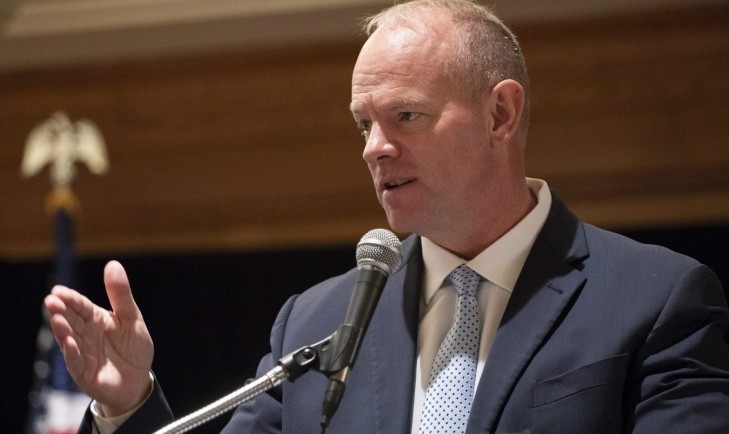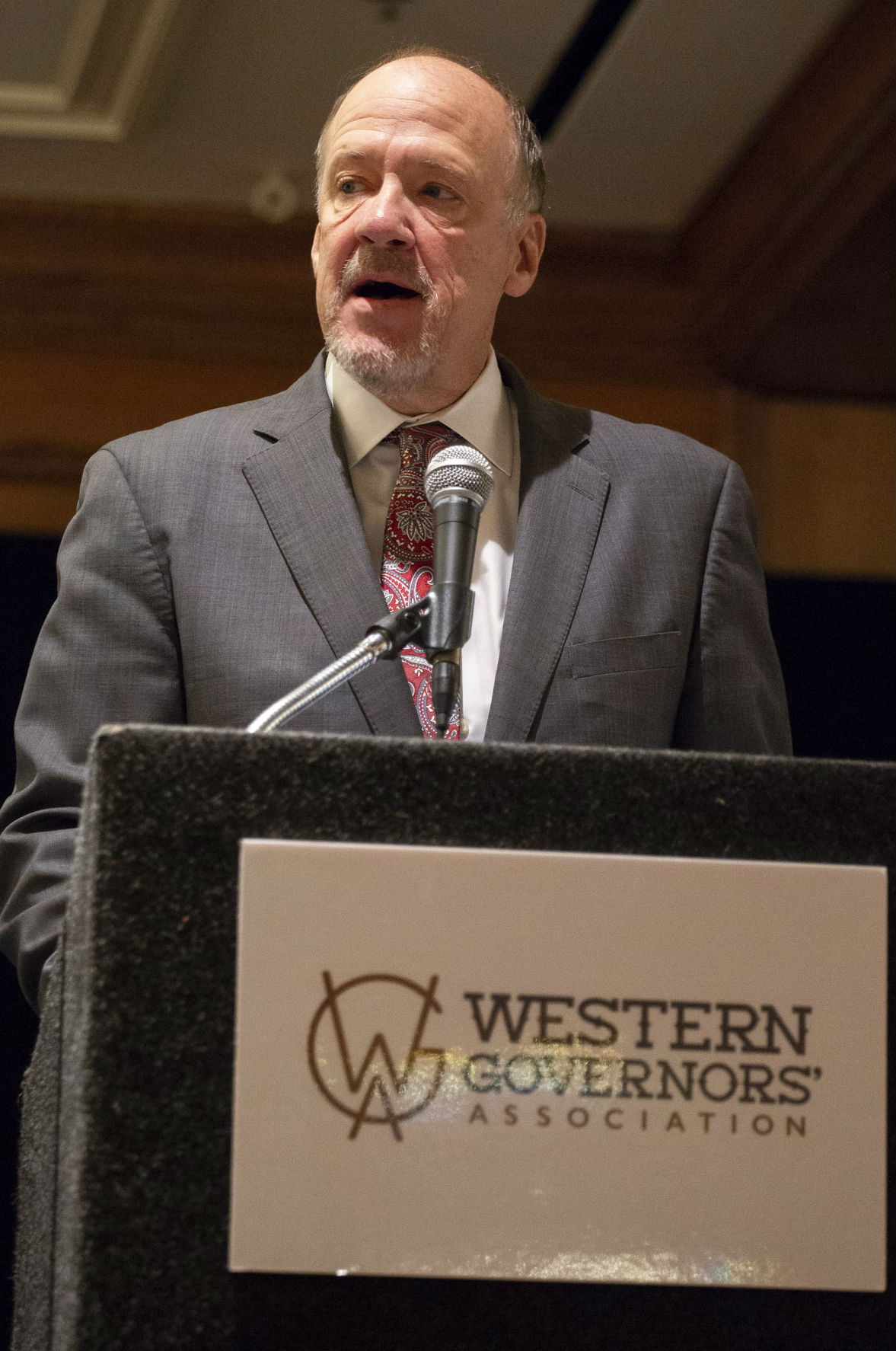10/10/18
Watch: Gov. Mead urges Working Lands Roundtable attendees to ‘make a difference’ in land management, invasive species policy

Wyoming Gov. Matt Mead urged attendees to “make a difference” on land management and invasive species policy at the WGA Working Lands Roundtable.
“You are sitting here today involved in a process that will work through the Western Governors and have potential for change in Congress. Time here is well spent because it can make a difference,” said Gov. Mead, whose remarks opened the two-day (Oct. 11-12) Western Governors’ Association (WGA) event in Cheyenne. "This is a place where answers can be found. This is not a place where bi-partisanship is just a talking point."
The Governor, a past Chair of WGA, detailed several invasive species, including cheatgrass and pathogens, that plague his state. And he reminded that the work is ongoing.
“We are worried about quagga and zebra mussels in Wyoming. To date, our work to keep them out of the state has worked. But I need to underscore the use of ‘to date,’ because it’s still a dangerous situation. We worry that it only takes one bad year to reverse years of good work. And we don’t just do this as a state, we do it as a region and that’s why it’s so important we all work together.”
Gov. Mead also noted the interconnectedness of the challenges. “If we can’t control cheatgrass, for example, what does that mean for sage grouse preservation? When wildfire destroys habitat, it makes it that much harder to preserve the species.”
Executive Director Jim Ogsbury opened the day by introducing WGA’s latest policy effort. The WGA Working Lands Roundtable is designed to bring together leaders in land management and invasive species on shared issues to examine crosscutting policy issues, engage a broad coalition of stakeholders and continue the work of past WGA Chair Initiatives and policy priorities.
 “The Roundtable,” Ogsbury explained, “is where the natural resources initiative will go to live, cross-pollinate, and prosper.”
“The Roundtable,” Ogsbury explained, “is where the natural resources initiative will go to live, cross-pollinate, and prosper.”
The event also included multiple panels focused on the work of the Western Governors’ Biosecurity and Invasive Species Initiative, which addresses the impact of invasive plants in sensitive species, rangeland restoration tools, livestock and wildlife disease and more. Learn more about the Chairman’s Initiative of Hawaii Gov. David Ige.
Below find links to watch videos of Day 1 and Day 2 sessions.
Thursday, October 11
Welcome & Opening Remarks: Jim Ogsbury, Executive Director, Western Governors’ Association, The Honorable Matt Mead, Governor of Wyoming
Restoration Following Invasive Species Impacts when Sensitive Species are Present
(Biosecurity & Invasive Species Initiative Session): Panelists discussed strategies and best practices to restore western landscapes affected by invasive species when threatened, endangered and other at-risk species are present. Panelists: Noreen Walsh, Director, Mountain-Prairie Region, US Fish and Wildlife Service; Tom Spezze, Senior Director of Conservation – Western US, National Wild Turkey Federation; Scott Smith, Deputy Director of External Operations, Wyoming Game and Fish. Highlights from panelists included:
- Noreen Walsh: “The question is not ‘Do we treat invasive species when sensitive species are present.’ It’s not a yes or no question. The question is ‘How do we treat those invasives when sensitive species are present?’ ”
- Scott Smith: “The state of Wyoming plays a leading role in the conservation of sage grouse. It remains a high-priority for us; Wyoming supports about 43 million acres of sage grouse habitat and 37% of the population nationwide.”
Rangeland Restoration Tools and Practices (Biosecurity & Invasive Species Initiative Session):
Land managers possess a variety of management tools to restore rangelands after an invasive species has been eradicated. This panel discussed best practices and emerging technologies for land managers as they plan rangeland restoration projects. Panelists: Colleen Faber, Environmental Health & Safety Supervisor, Anadarko, view slides; Dr. Peter Stahl – Professor of Soil Ecology, University of Wyoming, view slides; Garth Fuller, Eastern Oregon Manager, The Nature Conservancy, view slides; Derek Sebastian, Western Area Sales Manager – Vegetation Management, Bayer U.S., view slides. Highlights from panelists included:
- Derek Sebastian: “We’re getting these dense monocultures of annual winter grasses. This is decreasing ecosystem diversity and productivity while increasing fire risk. We’re having a regionwide transition from annual to perennial grasses.”
- Colleen Faber: "We want to place our sites where we have a good restoration opportunity. We look at the vegetative community and the composition of invasive species. We even try to proactively treat landscapes before we disturb them because it makes our restoration efforts easier and more effective."
Livestock and Wildlife Disease Management (Biosecurity & Invasive Species Initiative Session):
Brucellosis, chronic wasting disease, and other wildlife health issues affect a variety of western wildlife and livestock. Panelists discussed creative management options to address these challenging threats. Panelists: Scott Talbott, Director, Wyoming Game and Fish Department; Dr. Michael Miller, Senior Wildlife Veterinarian – Colorado Department of Wildlife; Kurt VerCauteren, Feral Swine and Ungulate Project Leader, National Wildlife Research Center; Dr. Camille Hopkins, Wildlife Disease Coordinator, Ecosystems Mission Area, USGS, view slides. Highlights from panelists included:
- Kurt VerCauteren: “We often think of big game species, but we also need to consider smaller species that use the same resources as livestock. They can pose a risk as a disease vector as well."
- Dr. Camille Hopkins: “We need to develop early detection tools through advanced technology. This will help with our rapid disease response options. New molecular tools have the ability to predict disease outbreaks in certain ecosystems before they happen.”
Natural Resource Data Management and Landowner Privacy (Biosecurity & Invasive Species Initiative Session): Effective invasive species response addresses threats across federal, state and private borders. Collecting species location data, however, can be a logistical and regulatory challenge on private property. Panelists discussed the practical challenges, as well as opportunities, of working across boundaries and engaging with private landowners in the data collection process. Panelists: Bobbie Frank, Executive Director, Wyoming Association of Conservation Districts; Shara Howie, Program Manager, NatureServe; Lisa Reynolds, Assistant Attorney General, State of Colorado, view slides. Highlights from panelists included:
- Lisa Reynolds: “Wyoming just successfully adopted an exemption for their open records act related to sensitive wildlife data, and I hope Colorado can figure out something similar. This will provide protections to landowners who share information about sensitive species on their property.”
- Jessica Crowder: "Landowners do want to provide this information. They recognize the importance of helping make species management decisions with the data they provide.”
Post-Fire Restoration Seed Strategy (WGA Working Lands Roundtable Session): The stabilization, rehabilitation and restoration of landscapes after wildfires and invasive species impacts require a viable national seed reserve. This panel will examine the status of seed strategies and seed reserves in the West and discuss how they relate to cross-cutting resource management efforts. Panelists: Peggy Olwell, Plant Conservation Program Lead, Bureau of Land Management, view slides, view Seed Strategy: Making Progress; Randy Crowl, Manager, Colorado Seed Lab, Colorado State University, view slides; Don Hijar – Owner, Pawnee Buttes Seed Inc. Highlights from panelists included:
- Randy Crowl: "Cheatgrass is a noxious weed in some states, but it is not listed as a noxious seed in any state. There’s a definite learning curve that exists for noxious weeds and seeds and how they relate to invasive species management."
- Don Hijar: "If you don’t start at the top of the watershed with planting something after a fire to stabilize the erosion, then that erosion is going to work its way down the landscape. Something that always makes sense is to stop erosion – wind or water – and you do it right away."
Active Rangeland Management and Invasive Species (WGA Working Lands Roundtable Session): Scientists and land managers will examine effective active management strategies to address the risks of invasive annual grasses on rangelands across the West. Panelists: Bob Budd, Executive Director, Wyoming Wildlife and Natural Resource Trust; Jeremy Maestas, Sagebrush Ecosystem Specialist, Natural Resources Conservation Service, view slides; Brenda Richards – Coordinator, Idaho Rangeland Conservation Partnership; Dr. Barry Perryman – Professor, University of Nevada – Reno, view slides. Highlights from panelists included:
- Barry Perryman: “Cheatgrass becomes very palatable in the fall after the seed drops. Cattle prefer it over other grasses. We ran an experiment where we grazed heavily from October to mid-December for three consecutive years. The next spring, there was barely any cheatgrass.”
- Bob Budd: “We have become obsessed with stopping disturbance. Disturbance is a natural part of these systems. We need to figure out how to live with disturbance and not go totally bonkers when it happens.”
Friday, October 12
Opening Remarks and Adaptive Management Policy Considerations (WGA Working Lands Roundtable Session): Adaptive management principles are applied on a wide variety of resource management issues. This panel examined how adaptive management is utilized at the intersection of forest, rangeland, invasive species, and species conservation policies. Panelists: Curtis Elke, Idaho State Conservationist, NRCS; Dave Pellatz, Executive Director, Thunder Basin Grassland Prairie Ecosystem Association, view slides; Willow Bish, Wildlife Biologist, Wyoming Game and Fish Department; Matt Holloran, Principal, Operational Conservation LLC; Gwyn McKee, President, Great Plains Wildlife Consulting. Highlights from panelists:
- Matt Halloran: “To make adaptive management work, we need to implement management and science together. Monitoring needs to be looked at as research. The difference is in the objectives pursued. This is a relatively slight shift in mindset in how we do management and research.”
- Willow Bish: One piece of implementing projects that we have found to be important is an annual site visit. When we were writing the grant, we identified areas that we thought needed to be treated, and some of the areas we expected to be covered with cheatgrass did not have much. That validation step was important because it allowed us to adjust our management strategy on the front end.
Restoration Challenges in Fire-Affected Landscapes (WGA Working Lands Roundtable Session): Fire management and restoration experts will discuss the unique restoration challenges that wildfire poses to Western landscapes. Panelists: Jim Hubbard – Under Secretary for Natural Resources and Environment, USDA; Bill Crapser – Wyoming State Forester; Jolie Pollet – Division Chief, Fire Planning and Fuels Management, Bureau of Land Management, view slides; Daniel Denipah – Forest Development Restoration Manager, Santa Clara Pueblo, view slides. Highlights from panelists included:
- Jim Hubbard: “The Shared Stewardship notion is that the Forest Service is going to sit down with states through governors’ offices and see what our shared objectives are. We are never going to treat the 80 million acres that need to be treated, but we have the analytical abilities to prioritize areas and make appropriate management decisions.”
- Jolie Pollet: In 2017, 30% more rangeland acres burned than forest acres did, but rangeland fires don’t tend to receive the attention that forest fires do.
Good Neighbor Authority and Disaster Recovery and Restoration (WGA Working Lands Roundtable Session): Good Neighbor Authority has provided federal and state land managers with greater flexibility in a wide array of management options. This panel examine how these authorities are utilized in disaster recovery and restoration efforts. Panelists: Jeff Whitney, Arizona State Forester; John Ruhs, Assistant Director, Fire and Aviation, Bureau of Land Management, view slides; Jim Neiman, President and CEO, Neiman Enterprises, Inc.; Mary Farnsworth, Deputy Regional Forester, Intermountain Region, USFS. Highlights from panelists included:
- Jeff Whitney: “If someone has capacity to do something under Good Neighbor Authority, then I don’t care who does it. I’d be happy to see tribes or counties getting good work done on National Forests under GNA agreements.”
- John Ruhs: “The joy of working with Good Neighbor Authority is the open framework and flexibility, so that will allow us to design innovative partnerships and projects moving forward.”
Get the latest news about the West and its governors by following the Western Governors' Association on Twitter, Facebook and LinkedIn.